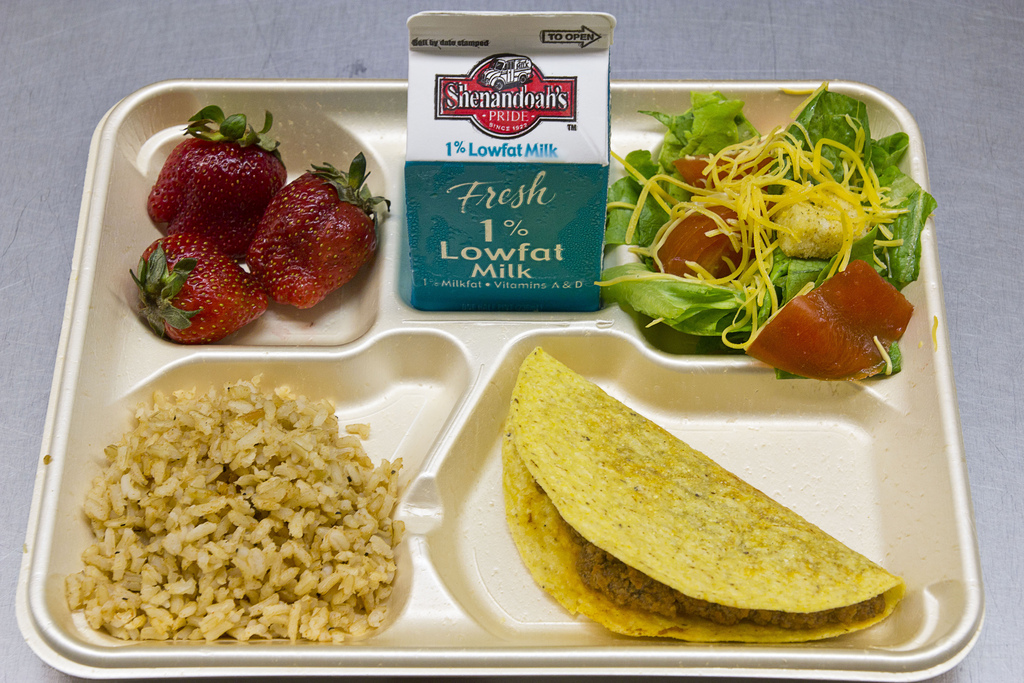A study published in the Journal of Nutrition Education and Behavior examined the amount of food wasted in school lunch after the new National School Lunch Program guidelines were implemented. This was done by observing food wasted by one pre-kindergarten class and five kindergarten classes for five consecutive days. It was found that almost half of all food served was wasted, with the majority of the waste was coming from vegetables, the main entrée, and then milk. The study made no claims as to the effectiveness of the new standards, as no previous study had been done under the former school lunch program but states that time should be spent researching and implemented waste-reduction efforts. This push to decrease the amount of food wasted is supported by findings of the study.1
Five kindergarten classes and one pre-kindergarten class from the same elementary school were observed for one week to measure the amount of food wasted. Food was pre-weighed and each item served to students was recorded. After students had finished their meal, the remaining food was then divided into separate bins for different items. The division of food was as follows: main entrée, fruit, vegetable, and milk. The bins were then weighed and the food waste was calculated based off of the individual food’s weight. Over the entire week, 304 meals which made up 4,988 ounces of food were served. Of this, 2,261 ounces were wasted or 45.3% of all food. Of all vegetables for the week, 51.4% were wasted, 51% of all main entrées were wasted, 45.5% of all milk, and 33% of all fruit.1
A strength of this study was the foresight to choose kindergarten and younger children. They were chosen partially because they would not have been served school meals under the former guidelines so they wouldn’t have rejected the new meals solely because they were used to the old menu. One limitation discussed by the author was that the school menu was set by the school district, and although it was compliant with the new National School Lunch Program guidelines, the food served under these guidelines can vary greatly. The author also mentions that according to research, younger children may waste more than older children, so the results may overestimate the amount of food wasted if generalized to all school children.1 A final limitation is the lack of previous research done on waste before the new guidelines.
Many chronic diseases that affect adults throughout this country are related to diet and nutrition. The onset of these diseases comes far before any symptoms arise and an effort should be made to stop these diseases before onset. The new guidelines were implemented in an effort to better the nutrition and health of the school children across the country. The National School Lunch Program decreases food insecurity2 and helps children get the foods rich in vitamins and minerals that they need. 80% of school children consume less than the recommended five servings of fruits and vegetables daily and the average student consumes over half of their fruit and vegetable intake at school3. School lunch does promote the nutrition of students, as found in a study comparing the nutrition of packed lunches to that of school lunches. This study found that packed lunches provided more calories, fat, saturated fat and sugar (along with more vitamin C and iron) and less protein, fiber, vitamin A, and calcium (and sodium) than school lunches under the new guidelines4. However, the argument can also be made that the new guidelines decrease food consumption in general and support an increase in food waste because of a lower perceived desirability to the children. A study that observed milk consumption, before and after chocolate milk was removed from cafeterias, found that total sales of milk (white and chocolate) fell 9.9% and waste of white milk rose5.It also found that sales of school lunch fell 6.8%5, a potential problem for schools that receive benefits from serving a specific number of students. This new study on food waste in schools supports the idea that the new guidelines could possibly be leading to an increase in food waste1.
The findings of this study on food waste are a good foundation for future research to compare the amount of food wasted as the guidelines continue to be implemented throughout schools. It can also be used as a background for future school lunch requirements. As these standards continue to be modified in the future, these results can be used as a comparison to identify trends in food waste.
Link to study: http://dist.lib.usu.edu/login?url=http://search.ebscohost.com/login.aspx?direct=true&db=aph&AN=98258834&site=eds-live
References:
1- Byker C, Farris A, Marcenelle M, Davis G, Serrano E. Food Waste in a School Nutrition Program After Implementation of New Lunch Program Guidelines. Journal Of Nutrition Education & Behavior [serial online]. September 2014;46(5):406-411. Available from: Academic Search Premier, Ipswich, MA. Accessed January 13, 2015.
2- Arteaga I, Heflin C. Participation in the National School Lunch Program and food security: An analysis of transitions into kindergarten. Children & Youth Services Review [serial online]. December 3, 2014;47:224-230. Available from: Academic Search Premier, Ipswich, MA. Accessed February 4, 2015.
3- Robinson-O’Brien R, Burgess-Champoux T, Haines J, Hannan P, Neumark-Sztainer D. Associations Between School Meals Offered Through the National School Lunch Program and the School Breakfast Program and Fruit and Vegetable Intake Among Ethnically Diverse, Low-Income Children. Journal Of School Health [serial online]. October 2010;80(10):487-492. Available from: Academic Search Premier, Ipswich, MA. Accessed February 4, 2015.
4- Farris A, Misyak S, Atzaba-Poria N, et al. Nutritional Comparison of Packed and School Lunches in Pre-Kindergarten and Kindergarten Children Following the Implementation of the 2012–2013 National School Lunch Program Standards. Journal Of Nutrition Education & Behavior [serial online]. November 2014;46(6):621-626. Available from: Academic Search Premier, Ipswich, MA. Accessed February 4, 2015.
5- Hanks A, Just D, Wansink B. Chocolate Milk Consequences: A Pilot Study Evaluating the Consequences of Banning Chocolate Milk in School Cafeterias. Plos ONE [serial online]. April 2014;9(4):1-7. Available from: Academic Search Premier, Ipswich, MA. Accessed February 4, 2015.
Photo courtesy of Flickr. Limited License: https://creativecommons.org/licenses/by/2.0/legalcode
Reviewed by Viktoriya Wolff
Apple rating: plus







